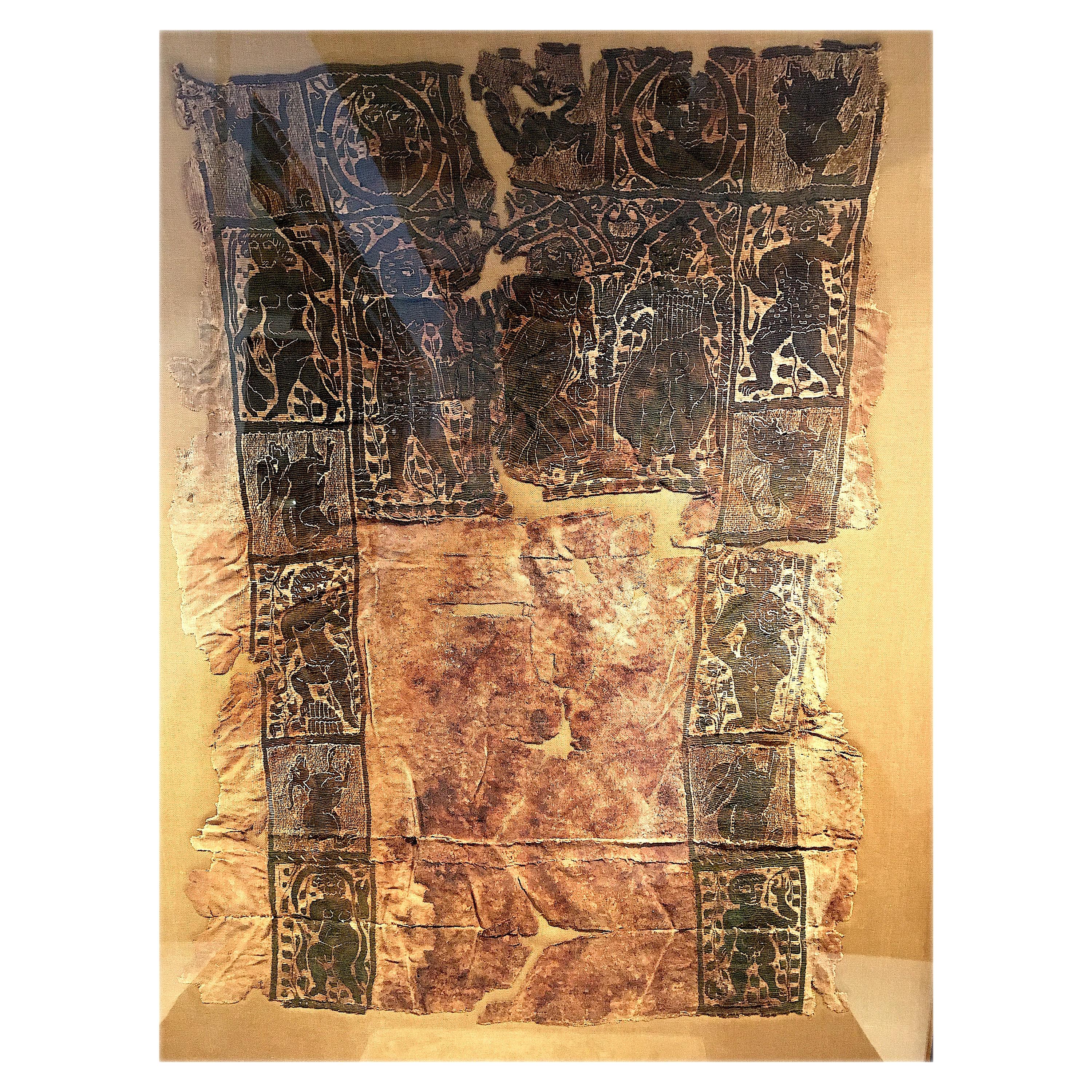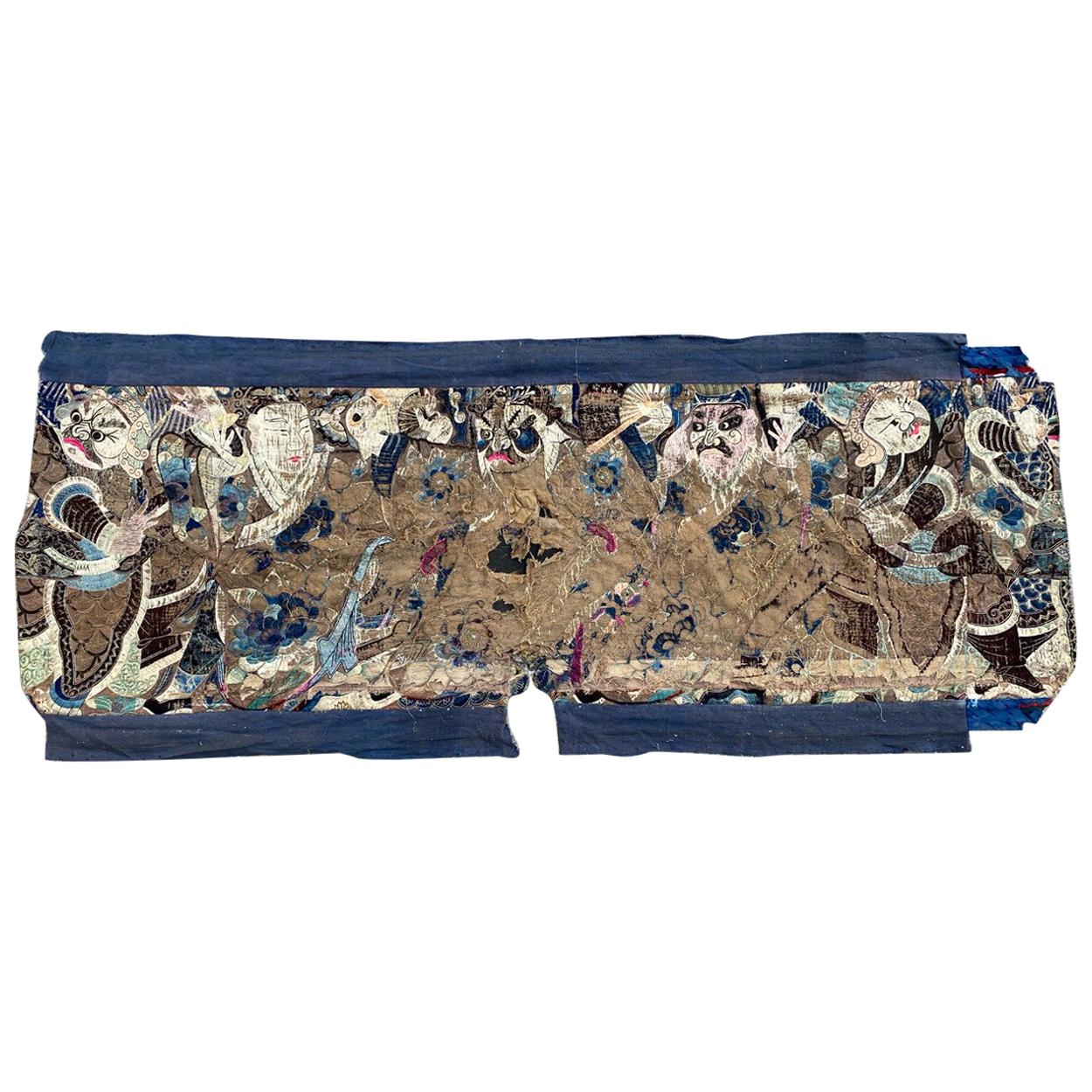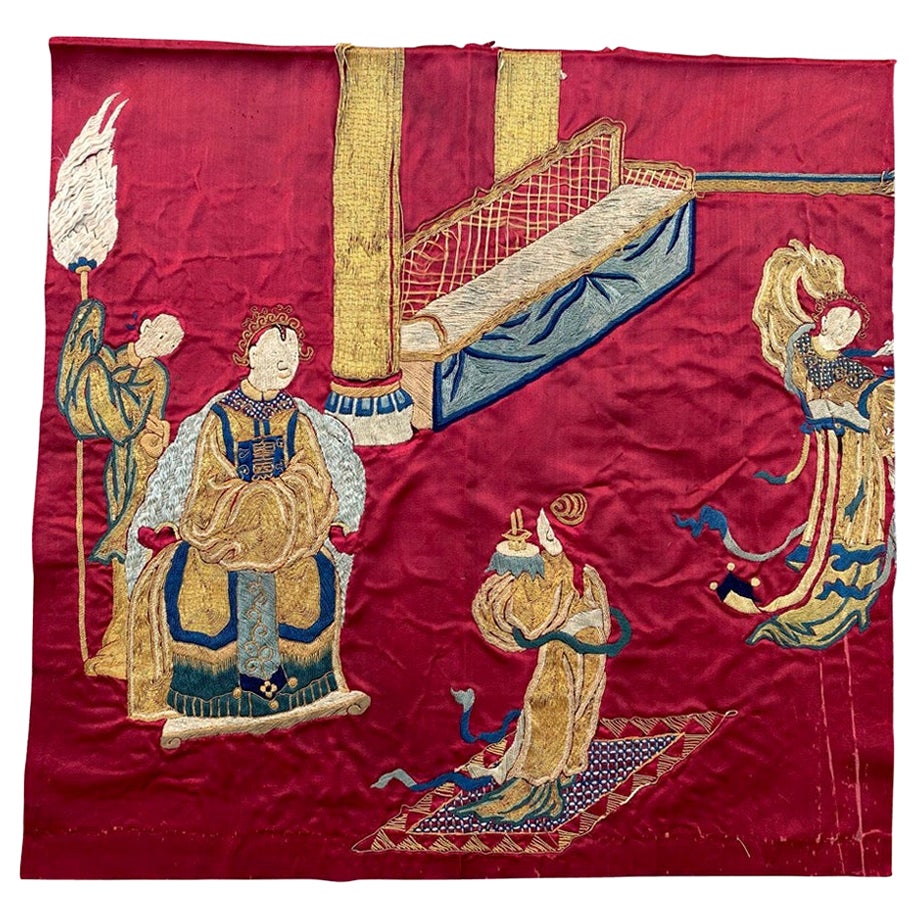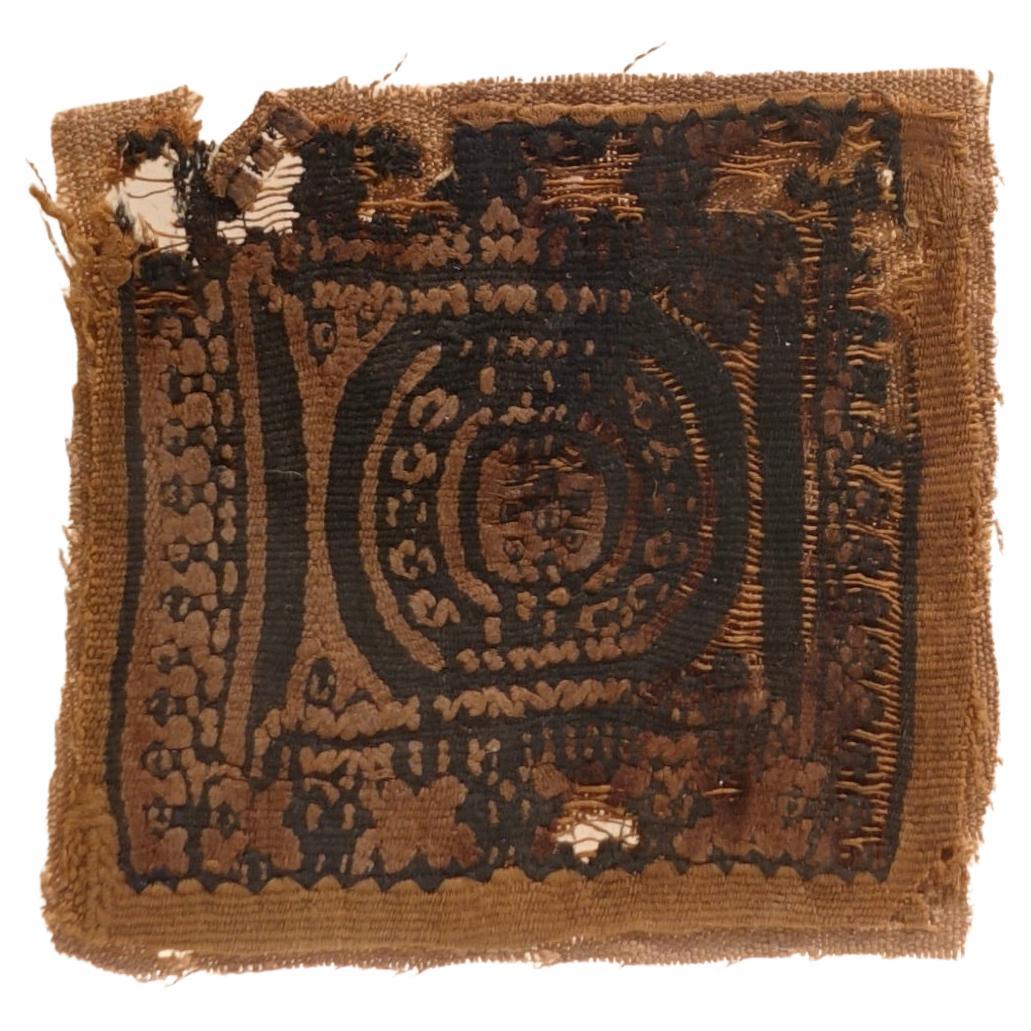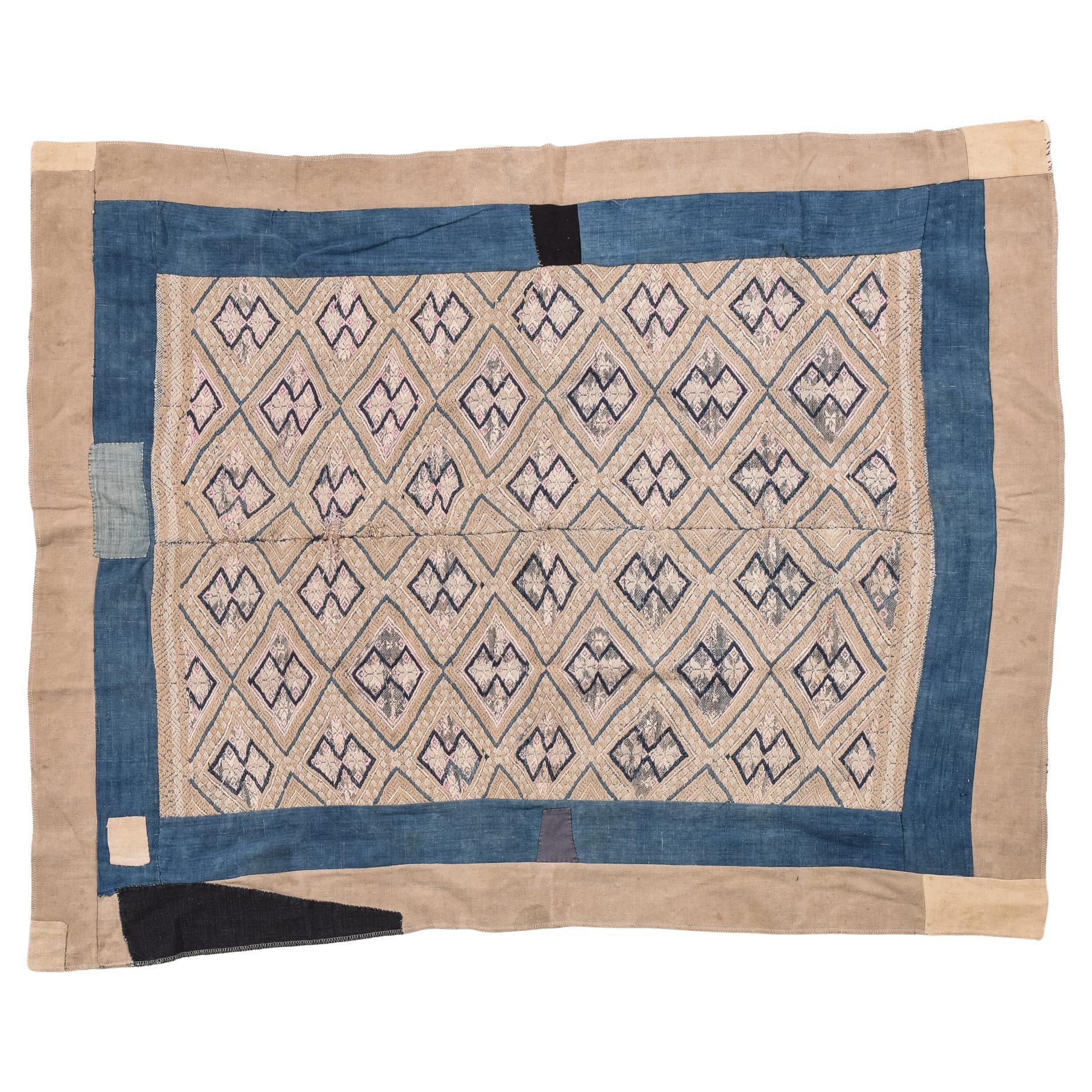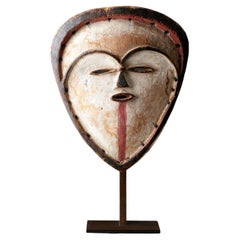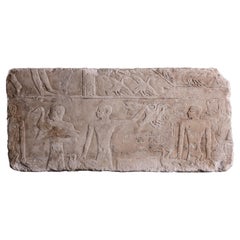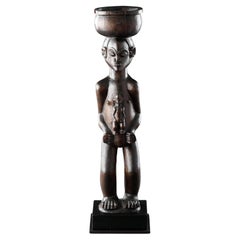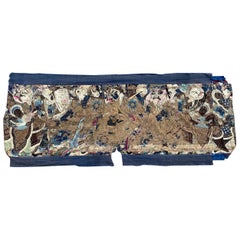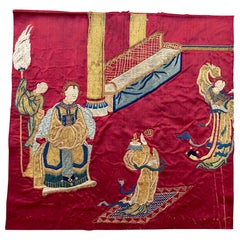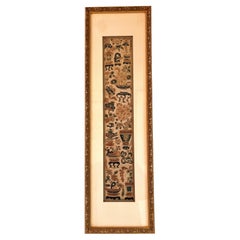Items Similar to A Very Rare Textile with a Scene of a Woman Opening a Door
Want more images or videos?
Request additional images or videos from the seller
1 of 9
A Very Rare Textile with a Scene of a Woman Opening a Door
$36,000
£27,485.84
€31,759.64
CA$50,537.19
A$56,328.96
CHF 29,553.87
MX$687,868.42
NOK 374,216.27
SEK 353,691.30
DKK 237,036.05
About the Item
A Very Rare Textile with a Scene of a Woman Opening a Door
Chain embroidery on damask
China
Late 5th century AD
Size: 26cm high, 30.5cm wide - 10¼ ins high, 12 ins wide
Provenance:
Ex Private collection
Ex Francesca Galloway Ltd, 2003
Ex private collection
note: radio-carbon date: 546 - 665 AD
The importance of silk in Chinese culture is attested by the attribution of its legendary discovery to the consort of the Yellow Emperor, the founder of Chinese civilisation. Sericulture, the rearing of silkworms for the production of silk filament, was the invention of Neolithic farmers living along the Huang Ho in north central China more than 4000 years ago. Through the centuries the state encouraged sericulture by making taxes payable in silk. The state controlled production to ensure the prestige of silk and to make its use an Imperial prerogative, demonstrating the special status of the aristocracy. Fine silk garments and furnishings marked special occasions in life and were often interred with the dead.
The Chinese art of silk and its production remained a closely guarded secret for over 3000 years. Its manufacture in a number of centres distributed throughout the Empire was one of the mainstays of the pre-modern Chinese economy, second only to agriculture in its value to the state and in the number of families for which it provided a means of support. Silk was also one of the first of China’s luxury products to be exported in large quantities both along the ‘Silk Road’ and by sea to the rest of Asia. Silk textiles were one of the major lures which brought merchants from the Islamic and Indian worlds, as well as from Japan, to the ports of China and they were eagerly sought after by the first European merchants to reach Canton, which was also the centre of a major weaving region.
To the ancient Romans, China was ‘the land of silk’ and during the Roman Empire it was imported exclusively from the East. It represented extreme refinement and luxury and became so desirable that the wearing of silk provoked a strong reaction from Senators who believed it to be a sign of decadence and a drain on the economy.
- Dimensions:Height: 10.25 in (26.04 cm)Width: 12 in (30.48 cm)Depth: 0.5 in (1.27 cm)
- Materials and Techniques:Silk,Embroidered
- Place of Origin:
- Period:15th Century and Earlier
- Date of Manufacture:Late 5th century AD
- Condition:Wear consistent with age and use. Minor losses.
- Seller Location:London, GB
- Reference Number:1stDibs: LU9363237206112
About the Seller
No Reviews Yet
Recognized Seller
These prestigious sellers are industry leaders and represent the highest echelon for item quality and design.
Established in 1989
1stDibs seller since 2023
- ShippingRetrieving quote...Shipping from: London, United Kingdom
- Return Policy
Authenticity Guarantee
In the unlikely event there’s an issue with an item’s authenticity, contact us within 1 year for a full refund. DetailsMoney-Back Guarantee
If your item is not as described, is damaged in transit, or does not arrive, contact us within 7 days for a full refund. Details24-Hour Cancellation
You have a 24-hour grace period in which to reconsider your purchase, with no questions asked.Vetted Professional Sellers
Our world-class sellers must adhere to strict standards for service and quality, maintaining the integrity of our listings.Price-Match Guarantee
If you find that a seller listed the same item for a lower price elsewhere, we’ll match it.Trusted Global Delivery
Our best-in-class carrier network provides specialized shipping options worldwide, including custom delivery.More From This Seller
View AllA Serene Vuvi Mask
Located in London, GB
A Serene Vuvi Mask
Wood, polychrome, pigment
Gabon
Early 20th Century
Size: 28cm high - 11 ins high
Provenance:
Ex collection Bertil and Eva Berg, Gothenburg, Sweden
Ex Privat...
Category
Early 20th Century Gabonese Tribal Art
Materials
Wood
$32,000
A Songye Male ‘Power’ Figure
Located in London, GB
A Songye Male ‘Power’ Figure
Open aperture to the head and stomach
Fine overall patina, loss to feet
Democratic Republic of Congo
19th Century
Size: 23cm high - 9 ins high
The ...
Category
Antique 19th Century Congolese Tribal Art
Materials
Wood
$16,500
A Fine and Large Egyptian Limestone Relief Carved in Shallow Relief
Located in London, GB
A Fine and Large Egyptian Limestone Relief Carved in Shallow Relief
Traces of original polychrome
Old Kingdom / 5th Dynasty / 2454 - 2311 B.C
Size: 32cm high, 70cm wide, 5cm deep - 12½ ins high, 27½ ins wide, 2 ins deep
Provenance:
Ex Private Swiss collection, acquired mid 1960s and thence by descent
Ex Rupert Wace Limited London
Ex Private London collection
cf A...
Category
Antique 15th Century and Earlier Egyptian Sculptures and Carvings
Materials
Limestone
A Large Finely Carved ‘Cup Carrier’ of a Women with Child
Located in London, GB
A Large Finely Carved ‘Cup Carrier’ of a Women with Child
Superb colour and rich patina
Wood
Tschokwe, Democratic Republic of Congo
Early 20th Century
Size: 42cm high - 16½ ins ...
Category
Early 20th Century Congolese Tribal Art
Materials
Wood
A Rare Standing Stone / Slab / Marker with ‘Triskele’ Low Relief Design
Located in London, GB
A Rare Standing Stone / Slab / Marker with ‘Triskele’ Low Relief Design
Sandstone
Late Celtic - Early Christian
7th – 8th Century AD
Size: 62cm high, 28cm wide, 19cm deep - 24½ i...
Category
Antique 15th Century and Earlier British Antiquities
Materials
Sandstone
A Finely Carved Polynesian Maori Feather ‘Treasure Box’ and Cover
Located in London, GB
A Finely Carved Polynesian Maori Feather ‘Treasure Box’ and Cover
With superb colour and patina
Wood, haliotis (abalone) shell
New Zealand
Early ...
Category
Antique Early 19th Century New Zealand Tribal Art
Materials
Wood
You May Also Like
Ancient Coptic Textile with Classical Figures
Located in Spring Valley, NY
Finely woven of wool and linen, this large, ancient, museum level Coptic textile depicts figures derived from classical antiquity, some playing musical ...
Category
Antique 15th Century and Earlier Egyptian Classical Roman Antiquities
Materials
Wool, Linen
Antique Distressed Chinese Embroidery
Located in Saint Ouen, FR
Distressed 19th century embroidery from China with a beautiful Chinese design and beautiful colors, entirely handwoven with silk.
Category
Antique Late 19th Century Chinese Chinoiserie Textiles
Materials
Silk
Bobyrug’s Antique Chinese Silk and Metal Embroidery
Located in Saint Ouen, FR
Very beautiful 19th century Chinese embroidery with nice design and beautiful colors, entirely hand embroidered with silk and metal on ...
Category
Antique 19th Century Chinese Chinoiserie Textiles
Materials
Silk
$1,132 Sale Price
20% Off
Fine Asian Silk Embroidery of Floral and Vases Motif
Located in Greenwich, CT
Fine silk hand embroidery, floral and vases motif in seed stitches and chain stitches, excellent colors and detail, 19th century
Conservation framed
Overall size: 26.5 height 8" w...
Category
Antique 19th Century Chinese Qing Textiles
Materials
Silk
Kapati textile - Epoque Byzantine; 4th–5th Century C.E
Located in Bruxelles, BE
Kapati Textile
Byzantine Period; 4th–5th Century C.E.
Materials: Plant and Animal Fibers, Wool
9,5 x 9,5 cm
This woolen fabric is woven in the traditional Coptic Kapati style, characteristic of Egypt during the Christian era. The name "Kapati" refers to the Copts of Egypt and describes a weaving technique that does not use embroidery or printing. It is said that Al-Muqawqis, the governor of Egypt, offered the Prophet garments made from Kapati fabric.
At the 1900 Exposition Universelle in Paris, the French archaeologist Albert Gayet showcased the results of his excavations from the winter of 1898-1899. Around one hundred Coptic textiles and fragments were displayed at the Palais du Costume. Their aesthetic generated considerable enthusiasm, particularly among artists like Auguste Rodin and Henri Matisse. This led to a "Coptomania," which, among other things, influenced fashion designers.
The square fragment features black decoration on a beige background; the two squares at the center are separated by scalloped edges, from which hang various ornaments or geometric motifs. At the center of the fragment is an image of a dancing figure surrounded by geometric decorations. This piece dates back to a time when ancient...
Category
Antique 15th Century and Earlier Egyptian Egyptian Antiquities
Materials
Wool, Natural Fiber
Ancient Rare GUAN-XI Embroidered Panel
Located in Alessandria, Piemonte
Ancient rare GUAN-XI embroidered panel in cotton and silk, from Southwest China.
it just needsto be mounted on a simple frame: I can do it on request, but the transport would cost mo...
Category
Antique Late 19th Century Chinese Other Pillows and Throws
Materials
Cotton, Silk
$742 Sale Price
30% Off
More Ways To Browse
Textile Art Weaving
Antique Chinese Textile
Antique Central Asian Textiles
Antique Indian Textiles
Islamic Textile
Antique Indian Door
Antique Radios
Yellow Damask
Antique Indian Embroidery
Antique Radio Art
Islamic Embroidery
Islamic Door
Canton Embroidery
Suzani Screen
19th Century Chinese Embroidery
Japanese Silk Embroidered
Framed Chinese Embroidery
Busts Of Moors
